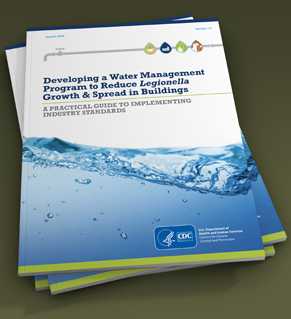Developing a Water Management Program to Reduce Legionella Growth and Spread in Buildings

Use the toolkit’s quick yes/no worksheet to find out if your building or certain devices in your building need a water management program.
A Practical Guide to Implementing Industry Standards
Many buildings need a water management program to reduce the risk for Legionella growing and spreading within their water system and devices. This toolkit is designed to help people understand which buildings and devices need a Legionella water management program to reduce the risk for Legionnaires’ disease, what makes a good program, and how to develop it.
Download the Toolkit

Provide Feedback
CDC welcomes feedback on this toolkit. Email RDB@cdc.gov with your thoughts and suggestions.
Background
Legionella, the bacterium that causes a type of serious lung infection known as Legionnaires’ disease, grows best in building water systems that are not well maintained. Some water systems in buildings have a higher risk for Legionella growth and spread than others. Legionella water management programs are now an industry standard for large buildings in the United States (ASHRAE 188: Legionellosis: Risk Management for Building Water Systems June 26, 2015. ASHRAE: Atlanta).
Scope of the Toolkit
This toolkit aims to provide an easy-to-understand interpretation of ASHRAE Standard 188 to help building owners and managers evaluate the water system and devices in their building(s) to see if they need a program, and then develop an effective water management program if one is needed.
The toolkit includes:
- A simple yes/no worksheet to determine if an entire building or parts of it are at increased risk for growing and spreading Legionella
- A basic walkthrough of the elements of a Legionella water management program
- Scenarios describing common water quality problems and examples of how to respond to them to reduce the risk for Legionella
- Special sections and considerations for those who work in healthcare facilities
Related Pages
- ASHRAE Standard 188: Legionellosis: Risk management for building water systems (ANSI approved)
-
Frequently Asked Questions: ASHRAE Standard 188
This webpage answers frequently asked questions about ASHRAE Standard 188, which outlines a legionellosis risk management program for buildings. - ASHRAE Guideline 12-2000: Minimizing the risk of legionellosis associated with building water systems
- Worksheet to Identify Buildings at Increased Risk for Legionella Growth and Spread
- What Owners and Managers of Buildings and Healthcare Facilities Need to Know about:
- Healthcare Water Management Program Frequently Asked Questions
- Page last reviewed: June 6, 2016
- Page last updated: September 14, 2017
- Content source:


 ShareCompartir
ShareCompartir